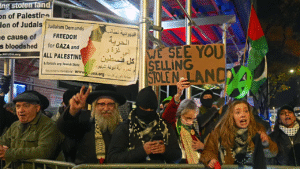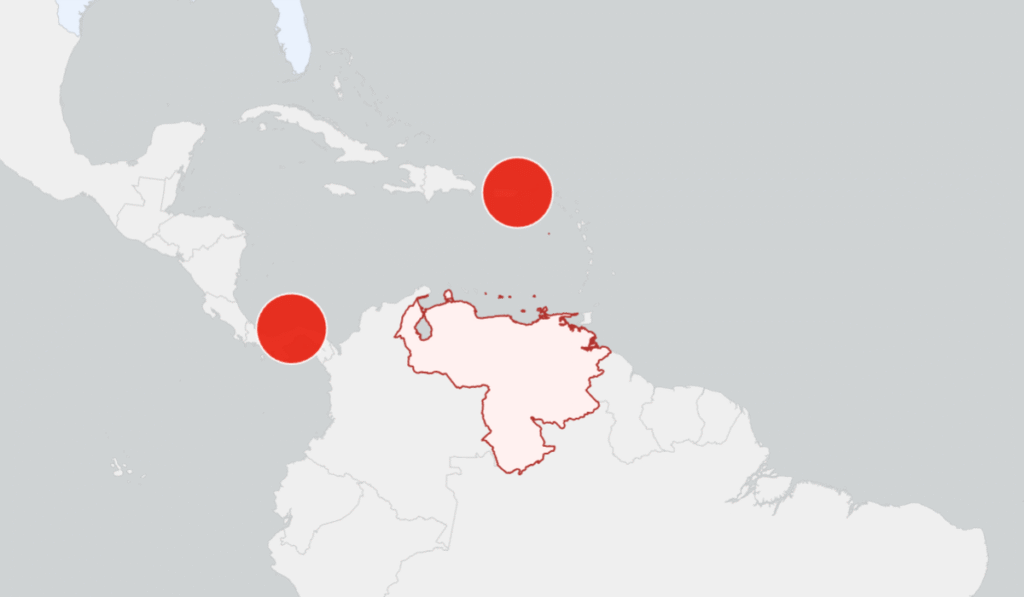Aô map by Newsweek shows how previously shuttered military bases in the Caribbean are coming back to life as the United States builds up its forces in the region.ô
The U.S. is returning to a siteô in Panamaô and building up another in Puerto Ricoô that have not been used for years amidô aô growingô U.S. military presence inô Latin America, coupled with repeated strikes on vessels President Donald Trump said were narcotics trafficking from Venezuela.ô
Why It Mattersô
The reactivation of U.S. military bases is a signal of intent from the Trumpô administration to exercise greater influence inô the Western Hemisphere and Latin America in general, and around the Caribbean Sea in particular.
Itô has led to heightened tensions with Venezuela, whose leader, Nicolas Maduro, has appealed for peace, and the deployment of a large number of naval forces to the region under the auspices of tackling drug trafficking in operation Southern Spear.
The Pentagon did not immediately respond to a written request for comment.
What To Know
U.S. troops and contractors have renovatedô Roosevelt Roads Naval Stationô in the Puerto Rican beachfront town of Ceiba. The base had been closed since 2004 and was in use as the civilian Josûˋ Aponte de la Torre Airport.
Satellite imagery revealed major renovations on the baseãs airstrip, tents for construction and an overhaul of the baseãs infrastructure, specialist military outlet The War Zone reported. Aô recentô CBS News report highlighted how U.S. forces hadô rebuilt key airfield infrastructure and begun sustained operations there at a time when U.S. air and naval assets move into the Caribbean.
The website Army Recognitionô reportedô that the base now hosts, among other assets, 10 F-35ô Lightning IIô aircraft,ô which have been stationed there for months, officially as part of the counternarcotics operationãalthough unofficially they appear to be a show of force directed at Maduro.
The reopening of Roosevelt Roads adds to the existing U.S. armed forces and Coast Guard presence in the territory, Newsweek‘s map shows, including at civilian-military airports in Aguadilla and San Juan, and at San Juan’s Fort Buchanan and Camp Santiago Joint Training Center, in Salinas.
Meanwhile, American forces have resumed operations at the former Fort Sherman in Panama, which had been out of use since Washington handed over the Panama Canal Zone in 1999.ô Over the last few weeks, troops carried out joint exercises with Panamanian units, focusing on ground maneuvers in the jungle.ô
A Pentagon official told Newsweek last week that theô regular troop movementsô were part of U.S.ô rotational forcesô that support the Joint Security Cooperation Group inô Panamaô and the Jungle Operational Training Course.ô
Felixô Cook,ô associateô director ofô corporate intelligence at security firm S-RM told Newsweek that Panamaãs president, Josûˋ Raû¤l Mulino, has swung sharply toward Washington since Trump started talking about reasserting U.S.ô control of the Panama Canal, therefore prioritizing “U.S.ô goodwill over his own votersã sentiments”.
U.S. officials have also discussed with Ecuadorô the possibility of American forces returning to the Manta air base for the first time since 2009, as well as the General Ulpiano Paez Airport, both of which are on the Pacific coast. However, the notion was rejected by voters in the South American country during a recent referendum.
Also in Newsweekãs map are Americaãsô footprintô in Cuba’s Guantanamo Bay, in addition to “cooperative security locations” in Curacao and Aruba, Honduras, El Salvador, and the U.S. Virgin Islands.ô
What People Are Sayingô
A U.S. Defense Department official told Newsweek:ô “We have military personnel stationed inô Panamaô conducting training with our local counterparts and other units involved in these efforts. This includesô logisticsô and engineering support aimed at improving the infrastructure of our partner nations.”
What Happens Nextô ô
The rebooting of old bases willô give the U.S.ô military greater operational capabilities in the region, according to the outlet Task and Purpose,ô which reported that they were providing key logistics support to U.S. warships and aircraft patrolling the Caribbean, including those with the Gerald R. Ford Carrier Strike Group. ô ô
Venezuelaãs government has said it was mobilizing its militaryô as speculation mounts over what the Trump administration will do next.ô
Read the full article here














